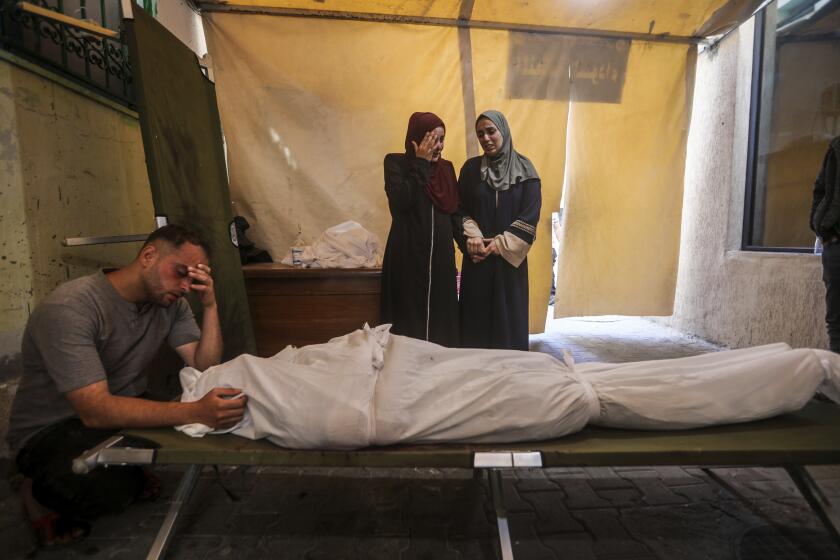Too often, teen dating poses a hidden risk
My older daughter’s love of horses has cost my husband and me a small fortune, but neither one of us is complaining these days. At 13, she prefers being at the barn to being out with boys -- and galloping around on horseback seems safer than having a boyfriend.
Dating poses risks that extend beyond the normal emotional ups and downs of a teen relationship, and violence associated with it is a widespread problem among teenagers. A national survey conducted in 2003 found that approximately 1 in 11 high school students had been victims of physical dating violence. More than 9% of students surveyed reported having been hit, slapped or physically hurt on purpose by their boyfriend or girlfriend.
This statistic actually underestimates the magnitude of the problem, because it takes into account only one form of dating violence. Sexual abuse, which can range from unwanted touching to forced sexual activity, is also common, with 24% of sexually active 15- to 17-year-olds saying they’d engaged in an unwanted sexual activity, according to a 2003 Kaiser Family Foundation report.
The most common type of abuse among teens, however, is emotional abuse. In some relationships, it takes the form of insults or mean-spirited teasing; in others, it involves out-and-out threats, accusations or possessive or controlling behavior.
Although boys and girls report dating violence at surprisingly similar rates, there are clear gender differences. Girls are more likely than boys to be the victims of sexual abuse, and the physical violence perpetrated by boys tends to be more severe than that inflicted by girls. “Girls suffer more serious injuries,” says Mitru Ciarlante, director of the Teen Victims Initiative at the National Center for Victims of Crime. “They also report more fear.”
Regardless of gender, dating violence takes a physical and emotional toll on its victims. Injuries are just part of the problem. Teens involved in abusive relationships are more likely to engage in unhealthy behaviors, such as binge drinking, and are at greater risk for depression and suicide. Dating violence is also associated with unhealthy sexual behaviors that can result in sexually transmitted diseases and/or unplanned pregnancy.
An abusive relationship during adolescence can affect future relationships as well. Patterns established early in life often carry over into adulthood.
Unfortunately, dating violence often goes unreported. Some teenagers simply want to try to solve problems on their own. Fear stops others from turning to an adult for help. They may worry that reporting the abuse will cause the violence to escalate or upset their peers. Some teens hesitate to get help because they fear losing the relationship itself.
Many victims also don’t report because they don’t recognize the problem. Teens have little experience in dating relationships and don’t automatically know what constitutes appropriate behavior. Extreme jealousy or controlling behavior, for example, may be misinterpreted as signs of affection.
“Violence is so widespread in their environment, victims may not see anything wrong with it,” Ciarlante says. Teens who witness their friends engaged in abusive relationships are less concerned about the violence when it happens to them.
Unfortunately, parents frequently fail to recognize the signs that their children are in trouble. “Generally speaking, the abuse is at a fairly severe level before families realize that it’s going on,” says Rose Pulliam, president of the National Teen Dating Abuse Helpline.
The National Teen Dating Abuse Hotline, (866) 331-9474, launched this year, provides teenagers with a private outlet to talk about their concerns. “It’s an opportunity for teens to involve adults that might be able to help,” says Pulliam. (Teens can also discuss the topic online at www.loveisrespect.org.)
Many experts believe that the best time to intervene, however, is before the abuse begins. Last year, the CDC launched a national initiative designed to prevent dating violence and promote healthy relationships. The program, Choose Respect, targets adolescents ages 11 to 14. It teaches the components of a healthy relationship and encourages behavior, such as honesty and compromise, that can be used to build such relationships.
Parents play a clear role in preventing dating abuse. Not only should they talk openly about the potential problem (asking about abusive behavior will not make it happen), they shouldn’t be afraid to step in if they have concerns.
“Teenagers still rely on their parents to help set limits,” Ciarlante says. “It’s important for parents to continue to parent.”
For now, that simply means another trip to the barn for me. I can even use the drive to talk to my daughter about relationships -- in preparation for the day when she begins to notice boys. I can see her eyes rolling already.
--
Dr. Valerie Ulene is a board-certified specialist in preventive medicine practicing in L.A. She can be reached at themd@att.net. The M.D. appears the first Monday of the month.
--
(BEGIN TEXT OF INFOBOX)
Warning signs of abuse
* Does he or she have unexplained bruises, scratches or injuries?
* Does the teen seem afraid of his or her boyfriend or girlfriend?
* Does the boyfriend or girlfriend seem to try to control the teen’s behavior, making all of the decisions, checking on his or her behavior, demanding to know who the teen has been with, and acting jealous and possessive?
* Does the boyfriend or girlfriend lash out, criticize or insult the teen?
* Does the teen apologize for the boyfriend’s or girlfriend’s behavior? Has the teen casually mentioned the boyfriend’s or girlfriend’s temper or violent behavior, but then laughed it off as a joke?
* Have you seen the boyfriend or girlfriend be abusive toward other people or things?
* Does the teen seem to be giving up activities or hobbies that were once important? Has he or she lost interest in school or other activities?
* Has the teen’s appearance or behavior suddenly changed?
* Has the teen stopped spending time with friends and family?
* Has the teen’s mood or personality changed? Is he or she becoming anxious or depressed, acting out or being secretive? Is the teen avoiding eye contact, having crying jags or getting hysterical?
* Has the teen recently started using alcohol or drugs?
Source: National Youth Violence Prevention Resource Center
More to Read
Start your day right
Sign up for Essential California for news, features and recommendations from the L.A. Times and beyond in your inbox six days a week.
You may occasionally receive promotional content from the Los Angeles Times.






